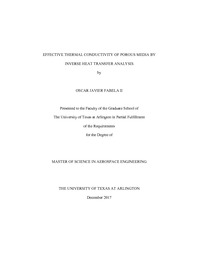
ATTENTION: The works hosted here are being migrated to a new repository that will consolidate resources, improve discoverability, and better show UTA's research impact on the global community. We will update authors as the migration progresses. Please see MavMatrix for more information.
Show simple item record
| dc.contributor.advisor | Dennis, Brian | |
| dc.creator | Fabela, Oscar Javier II | |
| dc.date.accessioned | 2018-02-15T20:15:29Z | |
| dc.date.available | 2018-02-15T20:15:29Z | |
| dc.date.created | 2017-12 | |
| dc.date.issued | 2017-12-07 | |
| dc.date.submitted | December 2017 | |
| dc.identifier.uri | http://hdl.handle.net/10106/27169 | |
| dc.description.abstract | This research describes the application of inverse analysis to estimate the thermal conductivity of a porous material using temperature measurements at the surfaces. Finite volume analysis code is implemented in MATLAB and it is utilized to solve the steady state, axisymmetric heat transfer governing energy equation.
The analysis code is coupled with a numerical optimization method and utilized to predict thermal conductivity using the measurements. An experimental setup was developed to test a porous media composed of a mixture of small pellets and air. In experiments, temperature is measured at outer surface of copper tube. These data, serves as input for the inverse analysis. Inside this copper tube, an electric heater is placed at center along with porous mixture at annular gap. Location of the heater is affirmed centrally by special manufactured fixtures and by being attaching at both ends. In addition, thermocouples were installed on the surface of the heater to measure the temperature. Validation of the finite volume code was carried out with ANSYS® and with experimental data. Here, Semi Analytic Complex Variable Method (SACVM) is used to determine the sensitivity of the predicted material properties on error in temperature measurements. This information is used to determine the locations on the surface of the copper tube to take temperature measurements, so as to reduce the effect of measurement errors on the inversely determined parameter. Temperature data at our equidistant locations on copper tube are used as input to the inverse analysis code. The objective function id minimization of least squares error between measured experimental and predicted temperatures. Conjugate Gradient Method (CGM) is used to solve the resulting problem. Accurate sensitivities for the CGM were computed by SACVM. A heater with diameter of 0.0128 m, and a copper tube with a diameter of 0.0296 m are used for these experiments. Top and bottom of heater and copper tube are insulated to force radial direction heat transfer. Convective heat transfer coefficient is assumed as 8 W/m^2 K and ambient temperature is 295 K. | |
| dc.format.mimetype | application/pdf | |
| dc.language.iso | en_US | |
| dc.subject | Porous | |
| dc.subject | Thermal conductivity | |
| dc.subject | Inverse analysis | |
| dc.title | EFFECTIVE THERMAL CONDUCTIVITY OF POROUS MEDIA BY INVERSE HEAT TRANSFER ANALYSIS | |
| dc.type | Thesis | |
| dc.degree.department | Mechanical and Aerospace Engineering | |
| dc.degree.name | Master of Science in Aerospace Engineering | |
| dc.date.updated | 2018-02-15T20:17:36Z | |
| thesis.degree.department | Mechanical and Aerospace Engineering | |
| thesis.degree.grantor | The University of Texas at Arlington | |
| thesis.degree.level | Masters | |
| thesis.degree.name | Master of Science in Aerospace Engineering | |
| dc.type.material | text | |
Files in this item
- Name:
- FABELAII-THESIS-2017.pdf
- Size:
- 2.234Mb
- Format:
- PDF
This item appears in the following Collection(s)
Show simple item record


